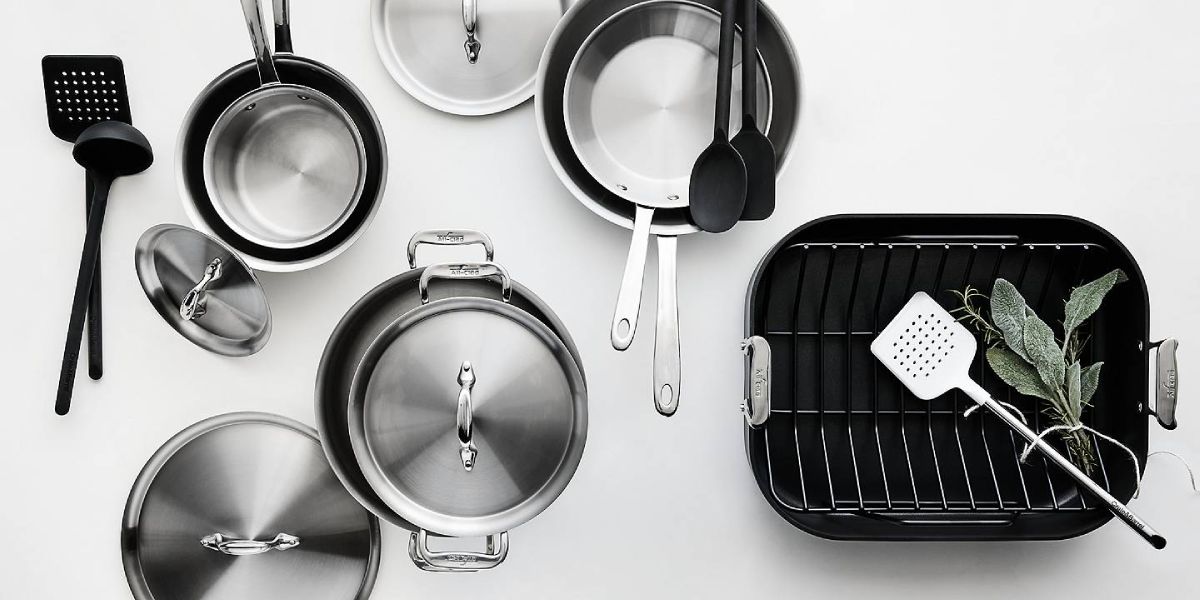• Cast Iron
The 7 Guidelines on How to Choose Cookware

Reviewed by Trinity Anderson
Last Updated December 2023

When faced with the daunting task of selecting cookware, the abundance of options can leave you feeling bewildered and inundated. With numerous excellent choices available, it becomes crucial to determine which ones are truly suitable for your needs. Should the process of finding the perfect cookware really be this challenging?
Allow me to simplify it for you.
Keep in mind that it all begins with your preferences and requirements.
Outlined below are seven essential guidelines to assist you in selecting the ideal cookware – tailored specifically to your needs.

1. Your Budget
When it comes to purchasing cookware, it is crucial to remember the golden rule: regardless of your budget, always strive to invest in the highest quality cookware set that you can comfortably afford. This is because cookware is not just a temporary purchase, but rather a long-term investment that will likely accompany you for many years, and potentially even be passed down to future generations.
2. The Material
You desire cookware made from a material that possesses exceptional heat conductivity, ensuring uniform heat distribution and eliminating any uneven hot spots in your pans. Additionally, the chosen material should not interact with the food being cooked.
Here’s a summary of the different materials, their pro’s and cons.
| MATERIAL | PROS | CONS | WHAT TO LOOK FOR |
|---|---|---|---|
| Stainless steel | Durable. Attractive appearance. Does not react with food. Easy to maintain. |
Poor conductor of heat. A bit of a learning curve to prevent food from sticking. |
Searching for stainless steel that has been combined with copper or aluminum in order to enhance its heat conductivity. |
| Aluminum | Excellent conductor of heat. Inexpensive. |
Very soft, dents easily. Reacts with acidic food. |
Search for hard anodized aluminum, a process that enhances the strength of aluminum to twice that of stainless steel and renders it non-reactive to food. |
| Cast Iron | Inexpensive. Durable. |
Requires seasoning to maintain. Heavy. Can react with food if not seasoned. |
The item can be either bare or coated with enamel. If opting for the enameled option, it is crucial to consider the quality and thickness of the enamel, as it may chip and mix with the food. |
| Copper | Excellent conductor of heat. | Very expensive. Reacts with acidic food. |
Consider searching for stainless steel cookware with copper cladding to benefit from the superior heat conductivity of copper at a more budget-friendly cost. |
Ideal options for home cooks include stainless steel cookware with an aluminum core, such as the Cuisinart Chef's Classic, or stainless steel cookware with a copper core, like the All Clad set. Having a core means there is an aluminum or copper disc at the bottom, sandwiched between layers of stainless steel.
It's important to note that cookware with copper will always be more expensive than aluminum. If your budget allows, look for stainless steel cookware with aluminum or copper cladding, which means there are layers of metal not just on the base but also up the sides.
This results in even and efficient heat distribution in the pan. This type of cookware is often referred to as tri-ply or multiclad cookware. Good choices in this category include Potluck Cookware, Cuisinart Multiclad Pro, or the All Clad 5 ply set.
If you're considering All Clad but find it too expensive, you can also check out Made In Cookware, a new company that offers American-made 5-ply stainless steel cookware with an aluminum core at a more budget-friendly price.
Another good option is hard anodized aluminum cookware with a nonstick coating, such as the Rachael Ray Hard Anodized Nonstick set. If you prefer ceramic coated pans, Caraway cookware offers excellent heavy gauge aluminum options.
If you want to ensure that no metals or chemical toxins leach into your food, 100% ceramic cookware like Xtrema is a great choice. Xtrema is completely free of any metals or chemical toxins, making it one of the safest cookware options available in the market today.
3. Your Cooking Personality
In a world where everyone has a unique cooking personality, it's important to understand your own. Whether you're a passionate gourmet chef or someone who enjoys throwing ingredients together, your cooking style influences your choice of cookware.
Simplifying things, there are two main categories of people when it comes to cooking:
Those who cook because they love to: If you fall into this category, you're likely to invest in high-quality cookware that will stand the test of time. You understand the value of durability and are willing to pay for cookware that will last a lifetime. Additionally, aesthetics matter to you, as you take pride in displaying your cookware in the kitchen. You also don't mind putting in the effort to maintain your cookware, knowing that it's a long-term investment. Ensuring the authenticity of flavors and avoiding any possibility of metal leeching into your food are also important to you.
For your cooking needs, stainless steel cookware with aluminum or copper cladding, copper cookware, and cast iron are excellent choices. Brands like All-Clad or Made In offer sets that are known for their longevity. If you're looking for quality cookware at affordable prices, Potluck cookware is a great option. And if you prefer metal-free cookware, Xtrema 100% ceramic cookware is a fantastic choice.
Understanding your cooking personality helps you make informed decisions when it comes to selecting the right cookware for your needs.
If cooking is a necessity for you, you may have the following considerations:
1. Cookware should be low maintenance and easy to clean, preferably dishwasher safe.
2. Convenience is a top priority.
3. Decent quality is important, but it should also fit within a budget. There are other expenses I prioritize.
4. I don't mind if my cookware shows signs of wear since I don't care about displaying it.
When it comes to choosing cookware, options like stainless steel with an aluminum core, such as the Cuisinart Multiclad Pro, budget-friendly triply cookware like Potluck (which you can read reviews about), or hard-anodized non-stick aluminum like Rachael Ray, are suitable for their convenience and ease of cleaning. It's worth noting that the Rachael Ray set now offers a dishwasher-friendly version, which is great news.
However, if you're looking for a cookware set that caters to both "love-to-cook" and "have-to-cook" personalities, I recommend considering Caraway Cookware. It not only looks great but also performs exceptionally well. The ceramic coating ensures that no harmful substances leach into your food, and it offers great convenience when it comes to cleaning up.
4. Your Type of Cooking
The type of cooking you engage in plays a significant role in determining the ideal cookware set for you. For instance, if you frequently sear and deglaze, stainless steel cookware might be the most suitable option. On the other hand, if stir frying is your go-to cooking method, cast iron cookware would be a better fit. For boiling purposes, a simple stainless steel stock pot would suffice.
It's important to note that there isn't a one-size-fits-all pan. However, by considering your specific cooking requirements, you can narrow down your options and find the cookware set that works best for you.
5. How many pieces you need
The number of people you cook for and your cookware personality will determine your kitchen essentials. If you are someone who cooks for a small family and considers it a necessity, then the basic must-haves for your kitchen include an 8" or 10" nonstick skillet, a 10" or 12" skillet with a lid, a stock pot with a lid, a sauté pan with a lid, and a saucepan with a lid. You can either look for a 7-10 piece set or choose individual pieces from open stock.
On the other hand, if you have a passion for cooking, you will require additional pieces such as extra saucepans, a larger stock pot, and possibly a cast iron skillet for your nonstick needs. Look for a set that is sized 14 or 17, or alternatively, you can select individual pieces according to your preferences.
6. Your Type of Stove
Cookware suitable for gas, glass, and ceramic cooktops can be made of any material. However, when it comes to glass and ceramic cooktops, it is important to ensure that the cookware is completely flat and made of a heavy gauge material.
On the other hand, if you have an induction cooktop, you need to use cookware that is magnetic since induction cooking relies on the transfer of magnetic energy. This means that regular Aluminum, Stainless Steel, Glass, Pyrex, or Ceramic cookware cannot be used.
Your options for induction cooktops include Cast Iron, Magnetic Stainless Steel, and certain brands of aluminum cookware that are specially designed for induction cooking. To check if a cookware is induction compatible, simply try sticking a magnet to the base of the pot. If it sticks, then it is likely to be suitable for induction cooking.
Take a look at this assortment of induction compatible cookware options.
7. What to avoid
Here are some items you should avoid when choosing cookware:
1. Avoid stainless steel cookware without aluminum or copper, as these materials are poor conductors of heat.
2. Stay away from basic aluminum cookware without any coating or anodization, as it is not durable and can react with food.
3. Don't opt for cheap nonstick pans that easily flake off.
4. Don't feel pressured to buy a pre-made cookware set if you don't think you'll need all the pieces. While sets are usually more cost-effective, it's pointless if you won't use all the pots.
5. Ultimately, the best cookware set for you might be a combination of different types of pans made from various materials, tailored to your specific cooking needs.